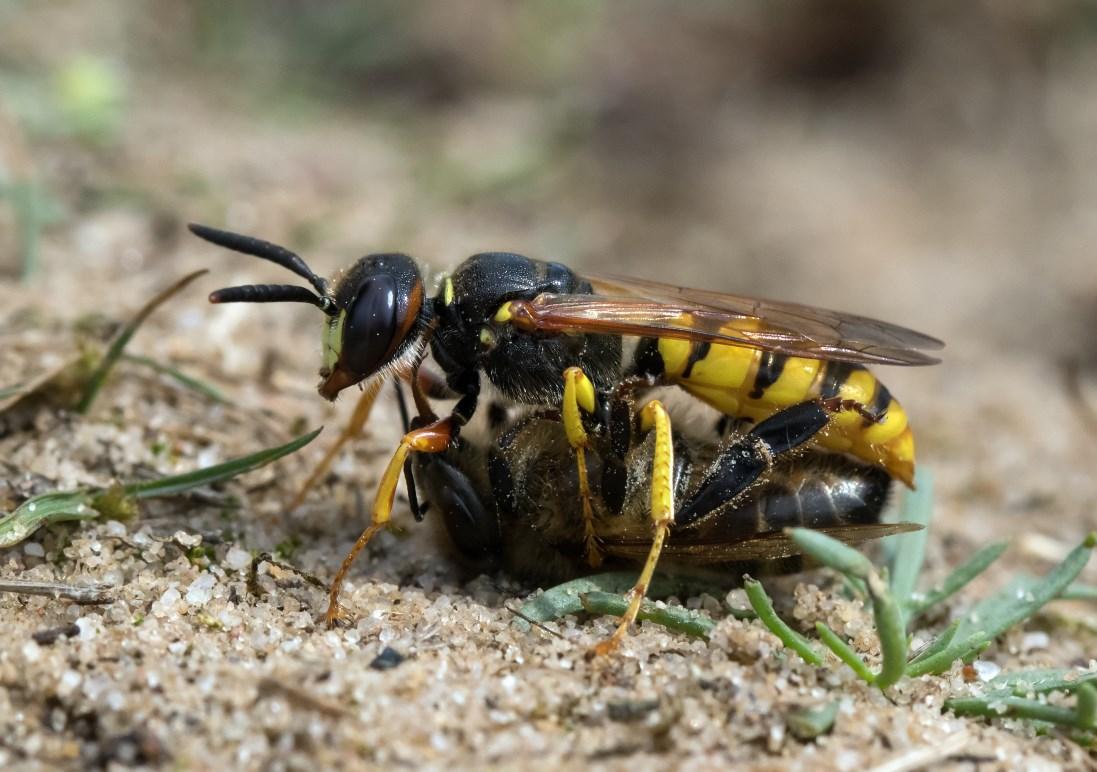
3 minute read
Wolves, Pantaloons and Parasites Steve Everitt, RSPB Volunteer
RSPB Minsmere is a large nature reserve and boasts a range of different habitats, all of which help keep it at the top of the species-diversity list. Years of careful work go into the initial creation and subsequent management of these different habitats, but sometimes the simplest of actions will lead to unexpected and interesting consequences. The path between the pond and the North Wall has been worn down over dozens of years by the footsteps of thousands of visitors. The result of all this gradual erosion is a path a few inches lower than the surrounding grass –and the sides of this path, sloping towards the sun, are now home to an increasing range of burrowing insects. We only really see them during the summer months, early July through into September maybe, but for those few short weeks they become some of the most fascinating species on the reserve.
It all started with the beewolf Philanthus triangulum, a digger wasp that specializes in catching honey bees and stocking its larder with them as a food source for its young. The bee-wolf starts by digging a tunnel up to a metre in length into the sloping sides of the path. The soil is easy to dig here, being so sandy, and the sloping sides help rain to drain away and avoid flooding the burrows.
Along that deep burrow, the bee-wolf carves little chambers – up to 30 – and stocks each chamber with 4-5 bees and a single egg. The bees have only been paralyzed by the wasp’s sting, not killed, as they stay juicier for longer like that and make better food for the wasp’s larvae! The bee-wolf also secretes a substance to coat the chamber which reduces fungus and bacteria, thereby keeping the paralyzed bees fresher for longer. The wasp carries the bees to her burrow slung underneath her, holding tight with a pair of legs just like a human child might grasp a giant teddy bear. They’re easy to spot flying in, the extra bulk making the flight slower and more ponderous than normal. All this work is done by the females. The males have a lek, just like capercaillie, showing off to the ladies in a small area along the same path. The views of the bee-wolves digging out their burrows (they’re like miniature Jack Russells) covering up or uncovering their hole to avoid someone stealing their home and taking the bees in (and occasionally throwing them out!) have captivated large numbers of visitors. Whilst the bee-wolves are no longer deemed rare in the UK, they are not that common and have been spreading north and west from our part of the country at a steady rate since the 1980s.
However, that is not all you can find along this stretch of path. To start with, there are other digger wasps inhabiting this area. Wasps specializing in catching spiders, weevils and even shield bugs can be found here, along with sand wasps and even the odd, brave, solitary bee (such as the green-eyed flower bee) digging itself a home. The “weevil wolves” especially have been plentiful this year and we have found a fair number of abandoned yet still twitching vine weevils to take away and show people under the microscope. However, all these wasps live in reasonable harmony, apart from the odd argument over burrow ownership. The bullies on the path are the German wasps. These look very similar to the common wasp we are used to, but they attack the bee-wolves, trying to get them to drop their precious cargo and steal it. If they can wrest the bee away, they will efficiently butcher it, chopping off legs, wings, heads – all they’re really interested in is the abdomen, which they will carry off, leaving the evidence of their dissection behind. Other bees have moved in this year too – pantaloon (or hairy-legged mining) bees Dasypoda hirtipes are also industriously digging burrows. In their case, it’s a 60 cm long burrow sporting chambers stocked with pollen and









